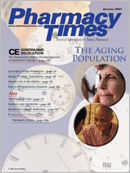ARTHRITIS WATCH
Weight Training May Slow Progression of Knee OA
A new study that used highly standardized x-ray proceduresshowed that strength training with weights can helpslow the progression of osteoarthritis (OA) in patients withOA of the knee. Researchers at Indiana University and PurdueUniversity studied 221 patients who were divided into 4groups; OA with pain, OA without pain, no OA with pain, andno OA without pain.
The patients were randomly assigned to partake in eitherstrength training or range-of-motion training for 30 months.Strength was measured and x-rays were taken at the beginningof the study and again after 30 months. The participantswere also asked to return for strength testing and pain assessmentevery 6 months after the first year.
The study results showed that all patients lost lower-extremitystrength over the course of the study, but the losswas slower with the strength-training group. In patients whohad OA at the start of the study, the average loss of joint spacewidth was 37% less in the strength training group andoccurred less often as well. During the final 6 months of thetrial, the strength group also showed better joint function. (Thefindings were published in the October 2006 issue of ArthritisCare & Research.)
Leg Length May RaiseArthritis Risk
According to a study conducted by the University ofNorth Carolina Thurston Arthritis Research Center, havingone leg shorter than the other could raise an individual'srisk of developing arthritis of the knee or hip. Individualswith a leg length difference of as little as 2 cm were morelikely to have osteoarthritis (OA) in their right hip or eitherknee. The study also showed that their OA was more likelyto be more severe. The findings were presented inNovember 2006 at the annual meeting of the AmericanCollege of Rheumatology.
The researchers looked at 3161 patients who wereenrolled in the Johnston County OA Project. Of thesepatients, 1785 had OA of the hip or knee, and 210 of themhad legs of different lengths. The researchers found thatpatients with differing leg lengths were more likely to havehip OA, compared with patients with equal leg lengths(32.5% vs 26.1%), as well as knee OA (45.3% vs 29.0%). Theresearchers hoped that these findings will help them "predictwho may develop OA and who may have symptomsthat worsen, or have potential risk of disability."
A Shot in the Arm—or Leg—Could Relieve OA
A new study showed that Botox, thepurified form of botulinum toxin type Atypically used for reducing facial wrinkles,also has positive effects on thereduction of pain of osteoarthritis (OA) ofthe knee, as well as improving kneefunction. The cosmetic injection hasshown promise in other medical areasas well, including excessive sweating,eye disorders, and certain neurologicalconditions. It is also being studied for thetreatment of headaches, ringing in theears, overactive bladder, and diabeticnerve pain.
Researchers at the MinneapolisVeterans' Affairs Medical Center areexcited by the preliminary results. Thestudy enrolled 37 patients with OA ofthe knee who are ineligible for jointreplacement, and they were studiedat 1-, 3-, and 6-month intervals afterinjections of either 100 units of botulinumtoxin plus lidocaine or saline pluslidocaine. After 1 month, the patientswith severe knee pain who receivedthe Botox shot showed a 28%decrease in pain and a 25% improvementin function, compared with noresponse in patients who received thesaline shot. The data were presentedin November 2006 at the annual meetingof the American College ofRheumatology.
Drug Shows Promise in Kids with RA
Researchers at the CincinnatiChildren's Hospital MedicalCenter have found that a medicineused to treat adults withrheumatoid arthritis (RA) has thepotential to help children withthe disease as well. Adalimumab,an antitumor necrosisfactor agent, was used in astudy of 171 children ages 4-17with juvenile RA. The studybegan with all the children takingthe medicine for 16 weeks,during which time 83% of themachieved a benefit of ACR Ped30—meaning, of 6 disease elementsdeemed important bythe American College ofRheumatology (ACR), at least 3showed improvement of >30%.
During that time, 52% of thechildren qualified for an ACRPed 70 result, and by the study'send, 1 in 5 had reached a benefitof ACR Ped 90, a "quite profound"benefit, according toresearchers. An 88-week extensionstudy continued to showimprovement in the conditionsof children taking adalimumab.Although the drug is currentlynot approved for use in thepediatric population, theresearchers hoped that theresults of this trial will promptfurther research that could leadto a new indication for the drug.The study's results were presentedrecently at a press conferenceat the annual meetingof the American College ofRheumatology.

